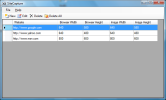


In traditional capture-recapture models, \(n\) individuals are captured at a site during the course of \(J\) sampling occasions. Both allow for user-defined functions to describe the capture process, and the latter allows for modeling of temporary emigration when data have been collected using the so-called robust design (Kendall et al.

unmarked has two functions for fitting capture-recapture models: multinomPois and gmultmix. In addition, spatial variation in abundance and capture probability can also be modeled using covariates. Capture-recapture models can be fitted with constant parameters ( \(M_0\)), time-specific parameters ( \(M_t\)), and behavioral responses ( \(M_b\)). 2005), which assume that capture-recapture data have been collected at a collection of sample locations (“sites”). This document focuses on the analysis of capture-recapture data using a class of models known as multinomial \(N\)-mixture models (Royle 2004, Dorazio et al. The three most common sampling methods that produce suitable data are removal sampling, double observer sampling, and capture-recapture methods. The “un” in unmarked is somewhat misleading because the package can be used to analyze data from marked animals.


 0 kommentar(er)
0 kommentar(er)
